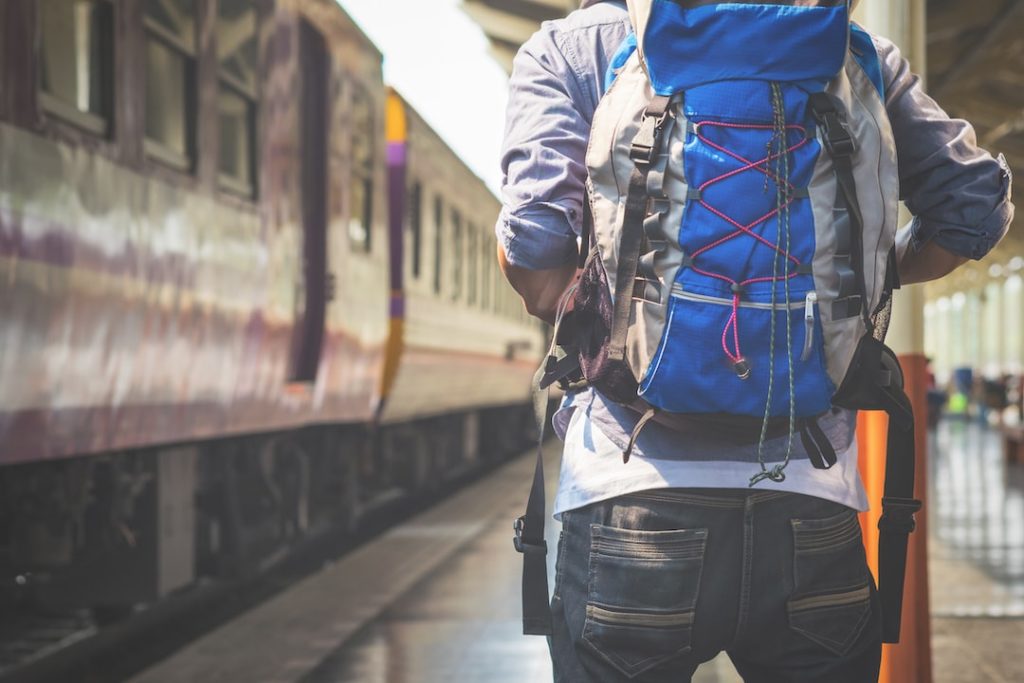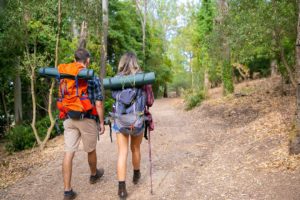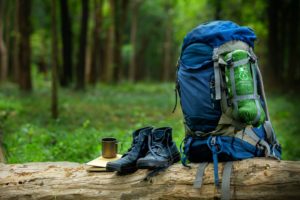
There are many types of travel: leisure travel, business travel, and then there’s backpacking.
Backpacking is a tradition for decades and has evolved into a popular form of travel.
There is debate over whether backpacking should be defined as “a person who travels with few belongings,” or “a person who travels with a backpack only.”
To many backpackers, the journey is what matters, not how it’s defined.
What is backpacking?
Backpacking is a form of travel in which the traveler carries everything they need on their shoulders—for ease of movement—instead of checking bags as most travelers do.
The word “backpack” may conjure images of high-tech gear designed for adventurers who trek miles upon miles each day. Still, backpacks used by travelers vary greatly based on the destination, weather, conditions, and length of the trip.
Typically, a backpacker will carry a day pack with water, snacks, a camera, etc… as well as what they need for overnight stays in hostels or cheap hotels.
Backpacking is like budget travel. But you have to carry everything you need instead of checking your bags at the airport’s baggage claim.
Backpacking originated in Europe during World War II when people were forced out of their homes. So they hit the road, hitching rides with soldiers who traveled from place to place. Travelers also built and slept in huts and caves along the way.
The simplicity of backpacking (traveling with a few items that you can buy at new locations) moved travelers from Europe to the United States and eventually further afield.
Today, backpacking has evolved past its origins and is done by people of all ages—from school-aged students to retirees—in various types of physical conditions.
The reason for “backpacking” is as varied as the places you take: experience a place without the distractions or overhead costs of vacationing; saving money on lodging and transportation; learn about yourself while exploring your world.
Another popular backpacking type is thru-hiking, which involves hiking one long trail through multiple states (for example, The Appalachian Trail in the US).
Thru-hikers typically in the spring at one end of the trail and hike toward its opposite end. If they complete the thru-hike, it is called a “thru-hiker.”
Thru-hikers who do not make it to the end of the trail often continue on another trail hoping to reach their major goal another day—like a metaphor for life!
How much does backpacking travel cost?
Backpackers have different budgets based on how long they plan to backpack and their choice of accommodations.
Some hostels offer free stays or work exchanges where travelers help with household duties offered free stay—others might require payment, but you can find plenty of deals online if you’re willing to look around.
Other places to find inexpensive backpacking travel include volunteer projects/work exchanges through organizations like WWOOF or HelpX, stay at farms, B&Bs, or cheap hotels.
Some backpackers also carry their own tents and share food they cook themselves (not always the safest idea in some locations).
Where can you backpack?
Backpacking is a prevalent form of travel that takes you all over the world.
You can backpack from one destination to another if you want an intense experience (for example: spending two months on The Appalachian Trail; flying to Kathmandu for a week before heading to Australia).
You can also start by traveling to a single country and see where it takes you—much like the original backpacking tradition.
Many travelers backpack around their own countries and then revisit favorite spots during future trips.
Traveling within your own country offers an experience of its own with language, culture, food, history—you’re bound to learn something new (and save money on travel) by choosing this option.

Some of the most popular places to backpack are:
-
The Appalachian Trail
The Appalachian Trail is one of the most popular backpacking trails in North America.
The trail is about 2,200 miles long and runs through 14 states in the eastern part of the United States.
This trail is so popular with backpackers because it spans a wide range of terrain, from lush forests to barren deserts.
It also connects to many other nearby outdoor locations, such as Shenandoah National Park, Big Cypress National Preserve, and parts of the Great Smoky Mountains National Park.
-
The Camino de Santiago
The Camino de Santiago is an ancient pilgrimage route that leads to sites of significance in the Spanish region of Galicia.
Historians believe Christians have used the path since the Middle Ages.
Today, pilgrims undertake this route as a physical and spiritual challenge. The journey can take up to four months, and some even walk for two years on their pilgrimage.
Many people choose to hike sections of The Camino, but others decide to do it all simultaneously.
Some of the most notable landmarks you’ll come across on your trek are:
>Santiago de Compostela Cathedral
>Pico Sacro (Sacred Peak)
>Plaza del Obradoiro
>Alviz Bridge
>Collado Vindeo Pass
-
Vietnam from North to South
Backpacking Vietnam from the north of the county to the south typically takes around three months (about 1,200 miles).
You’ll start in Hanoi and pass through scenic beaches, waterfalls, ancient cities, limestone karsts (bizarre land formations shaped by erosion), and much more.
Another popular option is to travel overland from Bangkok to Ho Chi Minh City. This journey can take 2-3 weeks, depending on how often you stop.
There are many places where backpackers can stop along the way, such as:
>Ba Be Lake
>Lang Son Market
>Ngoc Ha Reservoir
>Cuc Phuong National Park
>Mai Chau
>Halong Bay
-
The Colorado Trail
The Colorado Trail is perfect for backpacking because it’s a point-to-point trail that spans 800 miles.
The Colorado Trail is the “most scenic” of the National Scenic Trails and runs into the Rocky Mountains from Durango to Denver.
You’ll find endless adventures from hiking, biking, rafting, fishing, camping, or just sitting by one of the many lakes.
Depending on how much time you have and your pace, you can complete the trail in 2-5 weeks in the summer months and over five months during winter.
-
The West Highland Way
If you’re looking for an extended backpacking adventure, consider hiking the West Highland Way in Scotland (135 miles).
You’ll start in Milngavie and hike through scenic valleys, forests, hills, heather moors, stone farmhouses, and into some of Scotland’s most remote villages.
Many people walk the route in 7-9 days, but the trail can easily break it down into sections.
-
The Pacific Crest Trail
One of the most popular long-distance hiking trails is The Pacific Crest Trail (2,650 miles). This trail runs from Mexico to Canada along prominent ridges and through deserts, forests, and a few passes.
In all its entirety, this hike will take you 4-7 months, depending on how much time you have and your pace.
One thing backpackers like most about this trail is that it connects to three different public transportation systems: rail (Glasgow), bus (Edinburgh), or ferry (Loch Lomond).
-
Pennsylvania Wilds
The Pennsylvania Wilds is a rugged, forested landscape home to over 600 miles of scenic hiking trails.
You can choose from an extensive network of day-long hikes or longer backpacking adventures.
Backpackers can choose from trails ranging in length and difficulty level, leading to some of the unique and scenic destinations in Pennsylvania, such as:
>The Appalachian Trail (which runs through the eastern portions)
>Allegheny National Forest
>Elk Creek Indian Caverns
>Pine Creek gorge (a deep gorge along the boundary between Elk County and Clearfield County)
>Cherry Springs State Park (a state park for observing astronomical phenomena)
-
Rocky Mountain National Park
Rocky Mountain National Park has about 400 square miles and is the second-largest national park in Colorado.
One of the main reasons this park is so famous for backpackers is that it offers various hiking opportunities, ranging from day-long hikes to backpacking adventures.
A Rocky Mountain National Park hike usually starts at either Estes Park, Grand Lake, or Kawuneeche Valley.
Hikes often include such sights as:
>Moraine Park museum
>The Big Thompson River
>Deer Ridge Trail
>Paradise Creek Trail
>Boulder Falls Trail
One of the most famous day-long hikes (8 miles) in Rocky Mountain National Park is called Glacier Basin. This hike takes you to beautiful alpine lakes and provides spectacular views of the Continental Divide, Longs Peak, Mount Meeker, and Twin Sisters.
Another popular day-long hike is The Cub Lake Trail, which takes you around a small lake full of beavers and other wildlife in the middle of forests and meadows filled with wildflowers.
Backpacking trips in Rocky Mountain National Park usually focus on either the East or Westside.
The East Side: If you venture into the backcountry here, then expect to see lots of elk, bighorn sheep, moose, pikas (small mammals), marmots (large rodents), golden eagles, ospreys, mule, coyotes, ptarmigans (medium-sized birds), and willow ptarmigans.
You can go backpacking here from early summer to late fall.
The West Side: You’ll see even more wildlife here, including grizzly bears, black bears, mountain lions, lynx, wolves, mule deer, bighorn sheep, pikas (small mammals) marmots (large rodents), golden eagles, ospreys, and more.
Backpackers usually go from mid-July to September on the trails of this side.
If you have a few weeks or more, then consider traveling around some of these national parks with a backpack or hiking boots on your feet! Enjoy the adventure!
-
Kathmandu, Nepal
If you are looking for a challenging and rewarding adventure, then backpacking is the way to go! Kathmandu is a great place to start your experience.
Nepal is a mountainous country in South Asia with incredible natural beauty, rich culture, and history.
The country offers some of the most fantastic trekking opportunities in the world.
It is also home to eight of the highest mountains above eight thousand meters, including Mount Everest and Kanchenjunga.
Nepal backpacking trails offer various experiences that can take you through so many unique landscapes: tropical jungle, arid desert salt plains, barren dried-up riverbeds, and snowcapped mountain peaks.
You’ll see temples, pagodas, and mosques at your doorstep. Nepal is ideal for a spiritual pilgrimage, as religion plays a vital role in shaping Nepalese culture.
Cultural treasures abound in Nepal, including the stupa at Swayambhunath Temple, the sacred Hindu temple and monastery of Pashupatinath, and the towering ancient structure of Changu Narayan.
Nepal is also home to many ethnic groups that preserve their own unique cultures. The main population comprises Indo-Aryan and Tibeto-Burman peoples, while you can also find Mongoloid Rai people and smaller populations of various other groups.
-
Tajikistan
You can find a range of spectacular backpacking trails in Tajikistan, including the Pamir Mountains, famous for their enormous size—over 85% of this mountain range falls in Tajikistan.
Backpacking here is an opportunity to visit Lenin Peak, Ismoili Somoni Peak, Fedchenko Glacier, and Lake Suarez.
The Pamir Highway connects Dushanbe in Tajikistan with Murghab via three mountain passes: Ak Baital (4713 m), Oytag (4405 m), and Anzob (3478 m). Locals regularly use the last two, but the Akbaital is a daunting climb for everyone who dares to challenge it.
Besides its mountain ranges like the Pamir Mountains, Tajikistan offers impressive waterfalls like the Vakhsh River Gorge near Nurek Dam.
These falls create dramatic scenery and provide habitat to many endemic species of plants and animals.
-
Kyrgyzstan
Backpacking in Kyrgyzstan is rich in outdoor opportunities with crystal-clear lakes, high alpine peaks, waterfalls, and glaciers.
The country has the most glaciers in Central Asia aside from Tajikistan, part of its mountain range called the Tien Shan (Heaven Mountains).
Some of these include the Fedchenko Glacier and Lake Issyk Kul – the second largest lake in the world after Lake Superior.
Besides mountains and lakes, Kyrgyzstan offers a diversity of cultural experiences for backpacking travelers, including yurt stays with nomadic families around their home pastures where they raise sheep, horses, and cattle.
There are also many historical sites and monuments to explore, such as the Salt Ayub Cave Complex with its ancient rock paintings and the Tamgaly Tas (Precious Stones) Petroglyphs site with its historical Buddhist carvings.
How do you become a backpacker?
If you love adventure and don’t mind carrying everything you need for several months/years instead of checking bags at airports or loading bulky items into the back of your car–then becoming a backpacker might be right up your alley.
To get started, pick up one of the many books, magazines, or blog posts about backpacking and learn a little more about where you want to go.
Once you’ve settled on your destination(s), start researching accommodations and transportation costs—it might surprise you by how cheaply you can travel if you do some planning ahead of time and are willing to forgo certain amenities.
Some travelers spend years saving up before hitting the road, while others take out big loans before they depart (only advisable if you have a plan for paying it off).
Still, other backpackers find ways to work abroad during their travels.
There is something to be said for living like a local during your international expedition.
Is backpacking safe?
Backpackers seem oblivious to safety because they have a connection with the place they are exploring.
They take in every detail, concentrating on what is around them instead of their fears and preconceived notions about safety (and how tourists should behave).
For example: walking through crowded markets, taking photos, or interacting with locals can help travelers experience a destination at its fullest.
And as long as you follow general safety precautions—like using common sense with money management, dressing appropriately for your surroundings, avoiding certain areas—backpacking can be one of the safest forms of travel.
What should you bring on a backpacking trip?
The best way to decide what you need on your backpacking trip is first to determine where your travels will take you.
Are you headed for the mountains or on a beach adventure? Do some research and find out if any particular items might make your trip more comfortable, safe, or fun.
It’s always a good idea to contact hostels along a trail (or get travel information from the country) before arriving so they can help advise what gear would be helpful to have.
Once you’ve decided on the essentials for your backpack—make sure it’s high quality, lightweight, and in an appropriate size. Add in a daypack as well.
Can you backpack while pregnant?
Many women travel around the world while they are pregnant. But, of course, check with your doctor first before traveling (especially if you’re going far away).
It’s not rare for babies to be born on the road, so it’s best to be prepared.
All this being said, remember that every pregnancy and birth experience is different. So if something doesn’t feel right, listen to your body and make the best decision for you.
What are the benefits of backpacking?
There are so many benefits of backpacking.
Backpacking can make you less materialistic and more present in the moment, mentally and physically.
It can give you skills that will help you in other aspects of your life, such as being self-sufficient or having a high tolerance for discomfort.
If you want to become more social, backpacking is a great way to do it! You meet new people from around the world and get to know them on a personal level.
You also get to explore the world, all while saving money!
More benefits you will experience are:
-
You’re more mobile.
-
You have less baggage to deal with.
-
There’s a sense of adventure.
-
You don’t have to follow a fixed schedule or program.
-
It’s an affordable way to travel.
-
It’s easy to meet people from all walks of life.
-
It broadens your horizons.
Wrapping up
Backpacking has been a popular way to travel since the 50s when Americans took to the trails of Europe for a more budget-friendly way to explore.
Since then, backpacking has evolved into a culture all its own with popular trails around the world. In addition, there are hostels on the trail to gear stores catering specifically to this new breed of traveler.
Backpacking is one of the best ways to travel because it allows you freedom!
You can go almost anywhere globally, meet people who have completely different lifestyles than your own, and be committed only temporarily (as long as you want).
Backpacking is a great way to see the world, meet new people, and experience more than you would at home.
So go on an adventure! You can do it alone or with a group of friends. Whether it’s for two weeks or six months, enjoy every minute of your trip!
